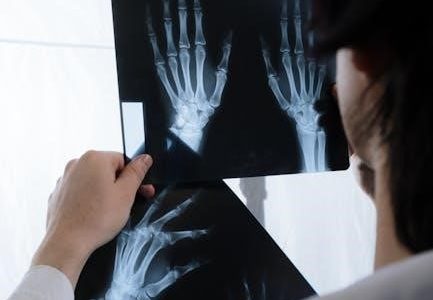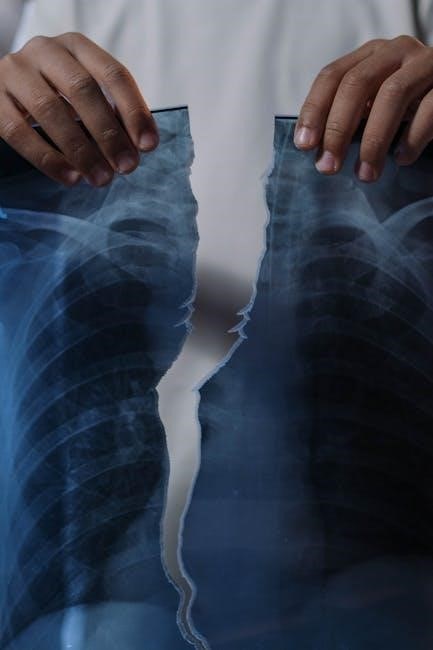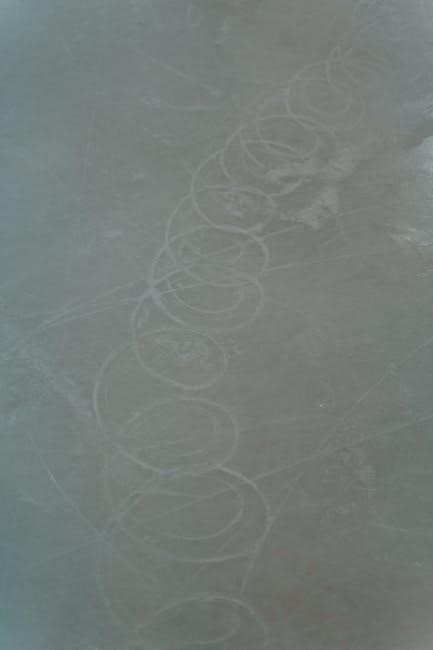
proximal humerus fracture exercises pdf
Proximal humerus fracture exercises are essential for restoring strength, mobility, and function after injury․ These exercises promote healing, reduce pain, and prevent stiffness, enabling a full recovery․
1․1 Overview of Proximal Humerus Fractures
A proximal humerus fracture occurs at the upper end of the humerus, near the shoulder joint․ It is a common injury, especially in elderly individuals with osteoporosis, often caused by falls or direct trauma․ The fracture can significantly impair shoulder function, affecting daily activities․ Proper diagnosis and treatment are crucial to restore mobility and strength․ Rehabilitation exercises play a key role in recovery, focusing on regaining range of motion, reducing pain, and preventing stiffness; Understanding the fracture’s nature and impact is essential for developing effective treatment and exercise plans tailored to individual needs․
1․2 Importance of Rehabilitation Exercises
Rehabilitation exercises are crucial for recovery from proximal humerus fractures, ensuring proper healing and restoring shoulder function․ They prevent stiffness, reduce pain, and promote mobility․ Early mobilization exercises, such as pendulum swings, improve joint movement and reduce inflammation․ Strengthening and flexibility exercises help regain muscle strength and range of motion, enabling patients to resume daily activities․ Consistency in rehabilitation is key to achieving full recovery and preventing long-term complications․ A structured exercise program tailored to individual needs ensures optimal outcomes and faster return to normal activities, emphasizing the importance of adherence and professional guidance throughout the recovery process․

Understanding Proximal Humerus Fractures
Proximal humerus fractures involve the upper portion of the arm bone near the shoulder․ Common in the elderly, they often result from falls or osteoporosis․ These fractures are classified based on displacement and angulation, influencing treatment․ Non-displaced fractures heal with immobilization, while displaced ones may require surgery․ Early diagnosis through imaging is critical for effective treatment, ensuring proper alignment and recovery․ Understanding the fracture type and severity guides rehabilitation, emphasizing the need for tailored approaches to restore shoulder function and mobility․
2․1 Classification of Proximal Humerus Fractures
Proximal humerus fractures are classified based on displacement and bone fragments․ Non-displaced fractures have minimal bone misalignment, while displaced fractures show significant angulation or separation․ The Neer classification system categorizes fractures into two main types: one-piece fractures (non-displaced) and multi-fragment fractures (two or more pieces)․ This classification helps determine treatment, with non-displaced fractures often managed conservatively and complex fractures requiring surgery․ Accurate classification ensures appropriate treatment and rehabilitation strategies, minimizing complications and promoting optimal recovery․
2․2 Common Causes and Risk Factors
Proximal humerus fractures often result from falls onto an outstretched arm or direct trauma to the shoulder․ Osteoporosis is a significant risk factor, especially in elderly individuals, weakening bones and increasing susceptibility․ High-energy trauma, such as car accidents, can also cause these fractures in younger populations․ Activities involving heavy lifting or repetitive overhead motions may contribute to stress fractures․ Additionally, poor bone density and advanced age impair bone resilience, making fractures more likely․ Understanding these causes and risks aids in prevention strategies and early intervention, reducing the likelihood of complications and promoting effective recovery․
2․3 Symptoms and Diagnosis
Common symptoms of a proximal humerus fracture include severe shoulder pain, swelling, bruising, and limited arm mobility․ Patients may experience difficulty lifting the arm or rotating the shoulder․ A visible deformity or abnormal alignment of the shoulder may also be present․ Diagnosis typically involves a physical examination, X-rays, and sometimes CT scans or MRIs for detailed imaging․ Classification systems, such as the Neer classification, help determine fracture severity by assessing displacement and fragmentation․ Accurate diagnosis is crucial for developing an appropriate treatment plan, whether surgical or non-surgical, to ensure proper healing and restore shoulder function effectively․

The Role of Early Rehabilitation
Early rehabilitation is crucial to prevent stiffness, reduce pain, and promote healing․ It helps restore mobility and strength, ensuring a smoother recovery and faster return to normal activities․
3․1 Preventing Stiffness and Promoting Healing
Gentle exercises are vital to prevent stiffness and promote healing after a proximal humerus fracture․ Early mobilization helps maintain joint mobility and soft tissue flexibility, reducing the risk of long-term stiffness․ By initiating controlled movements, patients can avoid muscle atrophy and promote blood circulation, which aids in fracture healing․ It is essential to balance activity with rest to ensure proper bone union without causing further injury․ Consistent adherence to prescribed exercises fosters a stable environment for recovery, leading to optimal outcomes and faster return to daily activities․

3․2 Reducing Pain and Inflammation
Early mobilization exercises play a crucial role in reducing pain and inflammation after a proximal humerus fracture․ Gentle movements, such as pendulum swings and passive range of motion exercises, help alleviate stiffness without putting excessive strain on the injured bone․ These exercises improve blood flow, which reduces swelling and promotes healing․ Pain management is further supported by avoiding heavy lifting and using assistive devices like slings to immobilize the arm during the initial recovery phase․ Consistent practice of these exercises, combined with medical guidance, ensures effective pain relief and inflammation control, fostering a smoother recovery process․

Stages of Rehabilitation
Rehabilitation for proximal humerus fractures is divided into distinct phases, each focusing on specific goals such as pain reduction, mobility restoration, and strength rebuilding to ensure optimal recovery․
4․1 Immediate Post-Injury Phase (0-2 Weeks)
This phase focuses on immobilization, pain control, and initial healing․ Patients often use a sling to protect the arm and minimize movement․ Gentle exercises, such as pendulum swings and wrist movements, may be introduced to prevent stiffness․ Pain management is prioritized, and early mobilization is avoided to allow proper fracture alignment․ Active-assisted exercises are typically postponed until the fracture stabilizes․ Monitoring by healthcare providers ensures the injury progresses toward healing without complications․ This phase sets the foundation for more intensive rehabilitation in subsequent stages, emphasizing rest and protection to facilitate optimal recovery․
4․2 Early Mobilization Phase (2-6 Weeks)
This phase introduces gentle exercises to restore basic shoulder mobility and strength․ Patients typically begin with pendulum swings, passive range of motion, and active-assisted movements․ These exercises help reduce stiffness and improve joint flexibility without putting excessive strain on the healing fracture․ Light resistance exercises may be added by 6 weeks, provided there is no pain or instability․ Activities focus on promoting blood flow and maintaining muscle tone․ It’s crucial to avoid heavy lifting or movements that cause discomfort․ Progression is gradual, ensuring the fracture remains stable while preparing the shoulder for more advanced rehabilitation in later stages․
4․3 Intermediate Phase (6-12 Weeks)
The intermediate phase focuses on enhancing strength, improving mobility, and preparing the shoulder for functional activities․ Patients progress to more dynamic exercises, such as scapular stabilization and resistance training․ Strengthening exercises target muscles like the rotator cuff and deltoids, crucial for shoulder stability․ Flexibility exercises are continued to maintain range of motion․ Weight-bearing activities are introduced cautiously, ensuring no discomfort․ The goal is to restore near-normal function, allowing patients to perform daily tasks independently․ Progression is individualized, with careful monitoring to avoid setbacks․ This phase sets the foundation for advanced rehabilitation and returning to pre-injury activities․

4․4 Advanced Phase (3-6 Months)
The advanced phase focuses on maximizing strength, endurance, and functional ability․ Patients engage in high-level exercises, such as plyometrics and dynamic resistance training, to restore power and precision․ Activities mimic real-life movements, preparing the shoulder for sports or heavy-duty tasks․ Proprioceptive exercises improve joint stability and coordination․ Stretching is refined to ensure full mobility․ Patients are gradually weaned off supportive devices, with emphasis on independent performance of exercises․ The goal is full recovery, enabling return to pre-injury activities without restrictions․ This phase ensures long-term durability and minimizes the risk of future injuries, promoting a seamless transition back to normal life․

Specific Exercises for Proximal Humerus Fractures
Exercises include pendulum swings, passive range of motion, active-assisted movements, scapular stabilization, strengthening, and flexibility routines to restore shoulder function and mobility after a fracture․
5․1 Pendulum Swings
Pendulum swings are a foundational exercise for proximal humerus fracture recovery․ They help improve shoulder mobility and reduce stiffness․ Patients lean forward slightly, supporting the injured arm with the unaffected hand․ The arm swings gently in small circles, first clockwise and then counterclockwise, for 10 repetitions in each direction․ This exercise is typically introduced 2-3 weeks post-injury, ensuring minimal strain on the fracture site․ Proper posture and relaxation of the shoulder muscles are crucial to avoid discomfort․ Pendulum swings are a low-impact way to restore range of motion and prepare the shoulder for more advanced exercises in the rehabilitation process․
5․2 Passive Range of Motion Exercises
Passive range of motion (ROM) exercises are crucial for maintaining shoulder mobility after a proximal humerus fracture․ These exercises involve a caregiver or therapist gently moving the injured arm through various motions, such as flexion, extension, and rotation, without active participation from the patient․ Passive ROM exercises are typically initiated within the first few weeks post-injury to prevent stiffness and promote healing․ They are performed while the arm is supported in a sling to minimize strain on the fracture site․ Regular passive ROM exercises help restore joint mobility, improve circulation, and prepare the shoulder for more active movements in later stages of rehabilitation․
5․3 Active-Assisted Range of Motion Exercises
Active-assisted range of motion (ROM) exercises are performed by the patient with the help of a caregiver or therapist․ These exercises begin once passive ROM is tolerated and typically start around 3-4 weeks post-injury․ The patient uses their own muscles to move the arm, but assistance is provided to reduce strain on the fracture site․ Movements include shoulder flexion, abduction, and rotation, all done slowly and within a pain-free range․ Active-assisted ROM exercises help improve strength, reduce stiffness, and prepare the shoulder for more independent movements․ They are a critical step in transitioning to active exercises and restoring functional mobility․
5․4 Scapular Stabilization Exercises
Scapular stabilization exercises are crucial for restoring proper shoulder mechanics after a proximal humerus fracture․ These exercises target the muscles around the shoulder blade, such as the serratus anterior and trapezius, ensuring the scapula moves correctly during arm movements․ Common techniques include wall slides, scapular push-ups, and resisted rows․ Patients are often guided to perform these exercises 3-4 times a week, focusing on controlled movements․ Strengthening the scapular stabilizers improves overall shoulder stability, reduces the risk of complications, and enhances the effectiveness of other rehabilitation exercises․ This step is vital for achieving long-term functional recovery and preventing future injuries․
5․5 Strengthening Exercises
Strengthening exercises are a key component of proximal humerus fracture rehabilitation, focusing on rebuilding muscle strength and endurance․ These exercises typically begin after the initial healing phase, around 6-8 weeks post-injury, and progress gradually․ Resistance bands, light weights, and isometric exercises are commonly used to target the rotator cuff, deltoid, and surrounding muscles․ Exercises such as shoulder rotations, lateral raises, and bicep curls are often recommended․ Proper form and pain-free movement are emphasized to avoid overloading the fracture site․ Strengthening enhances functional ability, allowing patients to return to daily activities and sports safely, ensuring a robust recovery and preventing future weakness․
5․6 Flexibility and Mobility Exercises
Flexibility and mobility exercises are crucial for restoring range of motion and reducing stiffness after a proximal humerus fracture․ Gentle stretches and mobilization techniques are introduced early in rehabilitation, often starting 2-3 weeks post-injury․ Pendulum swings, passive range of motion exercises, and active-assisted movements are commonly used to improve shoulder mobility․ Patients are encouraged to perform these exercises regularly to prevent joint stiffness and promote healing․ As progress is made, resistance bands or light weights may be incorporated to enhance flexibility and strength․ These exercises aim to restore full mobility, enabling patients to return to daily activities and maintain long-term shoulder health․

Progression and Modification of Exercises
Exercises are progressed based on fracture stability, pain reduction, and functional improvement․ Modifications adapt to individual needs, ensuring safe reintroduction of activities and maximizing recovery outcomes effectively․
6․1 Criteria for Progressing Exercises
Progression of exercises depends on fracture healing, pain levels, and functional improvement․ Clinicians assess range of motion, strength, and patient tolerance before advancing to more challenging activities․ Radiographic evidence of bone union and clinical signs like reduced pain and increased mobility guide progression; Patients must demonstrate control and stability in current exercises to safely transition to the next phase․ Individual progression ensures optimal recovery while minimizing the risk of re-injury or complications․ Regular follow-ups with healthcare providers are crucial to tailor exercise plans effectively․
6․2 Modifying Exercises for Individual Needs
Exercises for proximal humerus fractures are tailored to individual needs based on fracture severity, patient mobility, and overall health․ For non-displaced fractures, early mobilization with gentle range-of-motion exercises is prioritized to prevent stiffness․ In more complex cases or post-surgery, exercises may be modified to avoid stressing the repair site․ Pain levels and strength deficits guide adjustments, ensuring a safe and effective rehabilitation process․ Modifications might include reducing resistance, altering movement ranges, or incorporating assistive devices․ Regular assessments by healthcare providers help customize exercise programs, optimizing recovery and addressing specific patient challenges effectively․
Consistent rehabilitation and adherence to prescribed exercises are crucial for optimal recovery from proximal humerus fractures, ensuring restored function and a successful return to normal activities․
7․1 The Importance of Consistency in Rehabilitation
Consistency in rehabilitation is vital for optimal recovery from proximal humerus fractures․ Regular performance of prescribed exercises ensures gradual healing, prevents stiffness, and restores strength and mobility․ Adherence to a structured routine accelerates progress, allowing patients to regain functional use of their arm and shoulder․ Without consistent effort, recovery may be delayed, and full range of motion and strength may not be achieved․ Patients should follow their rehabilitation protocol diligently, as outlined in the provided PDF guides, to ensure the best possible outcome and a successful return to daily activities and pre-injury functions․
7․2 Returning to Normal Activities
Returning to normal activities after a proximal humerus fracture requires a gradual approach to ensure full recovery․ Most patients can resume light daily activities within 6-12 weeks, provided there are no complications․ Heavy lifting, overhead movements, and high-impact tasks should be avoided until cleared by a healthcare provider․ Consistent rehabilitation exercises, as outlined in the PDF guides, are crucial for restoring strength and mobility․ Patients can progressively incorporate pre-injury activities once pain-free range of motion and sufficient strength are achieved․ A well-structured rehabilitation plan ensures a safe and effective transition back to normal life and activities․